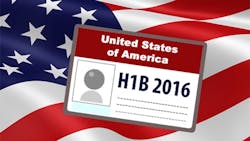For years, America’s high-skilled immigration system has struggled to fully take advantage of the talented individuals wishing to live and work in the United States.
Foreign students graduating from U.S. universities struggle to find ways to stay in the country and engineers and computer specialists from abroad, who are sorely needed in the United States’ STEM-deficient labor pool, often fail to get visas even when sponsored by a domestic employer. Increasing the number of H-1B visas, which allow companies to temporarily hire foreign workers for technology and engineering positions that are hard to fill because no native-born American candidates are likely available, would help the United States hire more skilled labor. Filling these important high-skilled positions would jumpstart the U.S. economy and support flagging competitiveness in advanced industries.
However, a single loophole that allows companies to use H-1Bs not to fill vacant positions, but instead to replace U.S. workers, has been utilized by a few employers. Isolated instances of this use of the visa have generated publicity that is used as fodder by opponents of high-skilled immigration who claim that these cases are indicative of all guestworkers.
In a recent New York Times article, Ron Hira of the Economic Policy Institute, stated that “the [H-1B] program has created a highly lucrative business model of bringing in cheaper H-1B workers to substitute for Americans.”
A subsequent Times editorial described the H-1B as a shortcut to “cheap, exploitable, disposable labor.”
In another case, when Southern California Edison used the loophole to replace technology workers in possibly the most widely publicized case to date, H-1B visas were disparaged by IEEE-USA as an "endemic" method of outsourcing.
Visa Fills Gaps
However, the broader picture is that most H-1Bs serve the purpose for which they were designed: to fill skill gaps in the U.S. labor market and bring skilled workers into the country.
Demand for technology workers has never been higher. Indeed, many of the record 5.4 million positions currently open in the United States are tied to the shortage of STEM workers.
Companies facing costly hiring difficulties face a tough choice: Remain uncompetitive with under-qualified U.S. workers, pay to poach workers from other companies and industries also facing shortages, fill the positions with foreign-born and often U.S.-educated professionals, or leave the position unfilled and forfeit an opportunity for growth. The last option is more and more common. We need more technology and engineering workers to unlock economy-wide growth.
The growth these foreign-born workers help spur is beneficial to native-born workers as well. Guest workers actually create 1.3 jobs a piece in their own industry, as jobs working with high-skilled guest workers appear for currently un-employed or under-employed native-born workers.
Thus, guest workers serve as a complement, not a substitute, for native-born workers.
It’s as if the United States has a shortage only of left shoes: The right shoe is only useful if we can find a way to access its partner.
Furthermore, there is a robust multiplier effect from foreign technology workers spending locally, which creates 4.3 American jobs in other local service industries. The United States seems poised for rapid growth, and all we need to do is let people in.
Moreover, despite the insistence of the Economic Policy Institute and others that the H-1B is simply used to recruit people who are willing to work for a fraction of prevailing domestic wages, these high-skilled workers actually earn more than native-born workers when controlling for age and occupation.
This trend can be observed broadly across most technology and engineering occupations, as well as among contractor firms that specialize in placing H-1B workers.
Tata Consultancy Services and HCL America, companies cited as “offshoring” specialists, pay guest workers a median income of $67,700 and $71,200, respectively, roughly $30,000 above the national median wage. In short, guest workers have unique skill sets that command competitive wages, and they are compensated accordingly.
Why use contractors if not to undercut wages? Companies frequently use specialized staffing consultancies to hire H-1B workers due to the complexities of the application process, the difficulty of recruiting abroad, and the uncertainty associated with the lottery process for scarce visas.
In most cases, working with a contractor that specializes in these visas makes sense for a U.S. company looking to hire high-skilled professionals when it cannot find native-born workers to fill a position.
Cases of honest, hard-working Americans in good jobs being replaced by guestworkers are anecdotal rather than systemic. Moreover, such abuses could easily be fixed through targeted reforms that make companies using contractors adhere to the same standards as direct H-1B petitioners.
Vilifying the H-1B visa as a scapegoat for America’s stubbornly slow-to-improve unemployment rate ignores the immense economic benefits for both firms and workers that are unlocked through high-skilled immigration.
Adams Nager is an economic research analyst with the Information Technology and Innovation Foundation.
